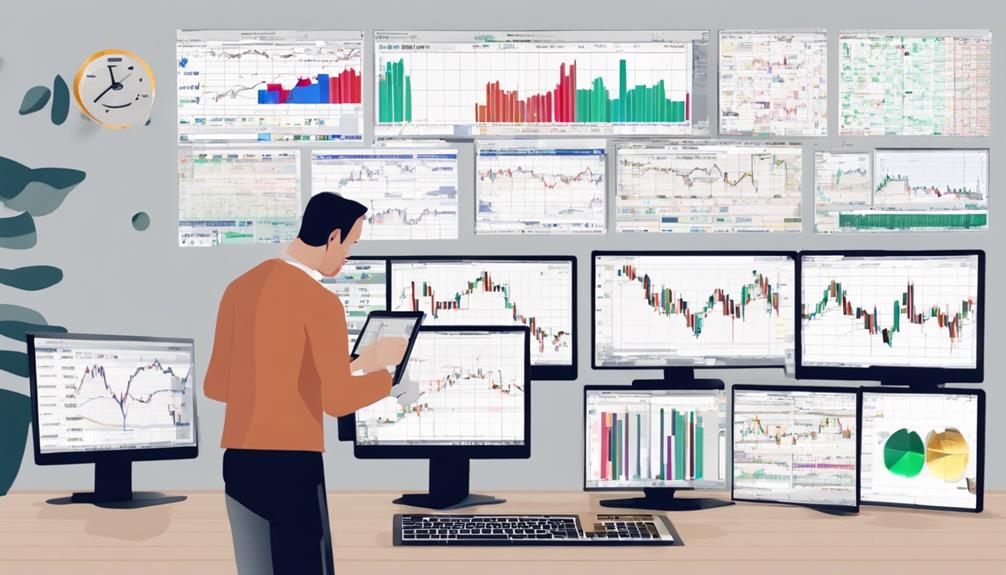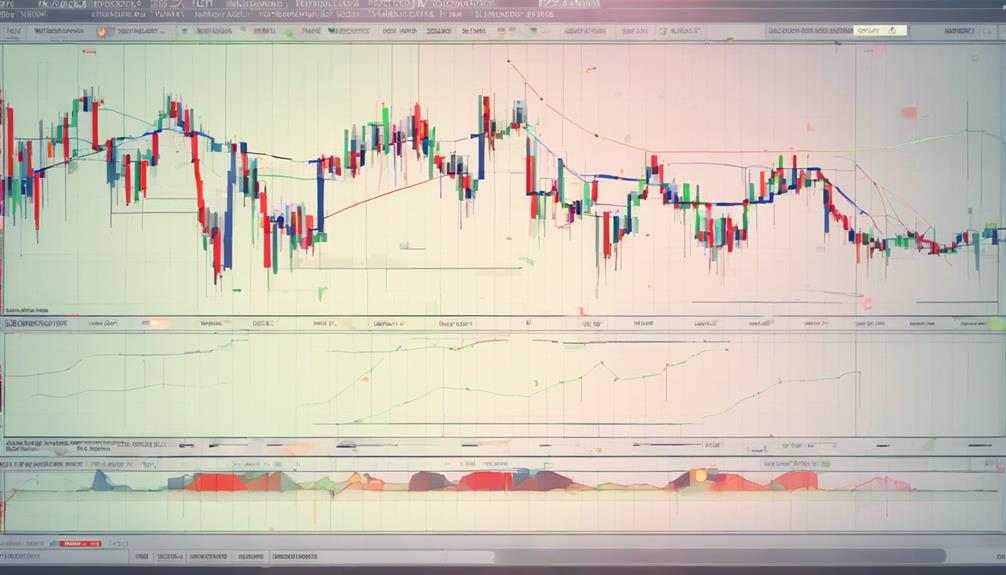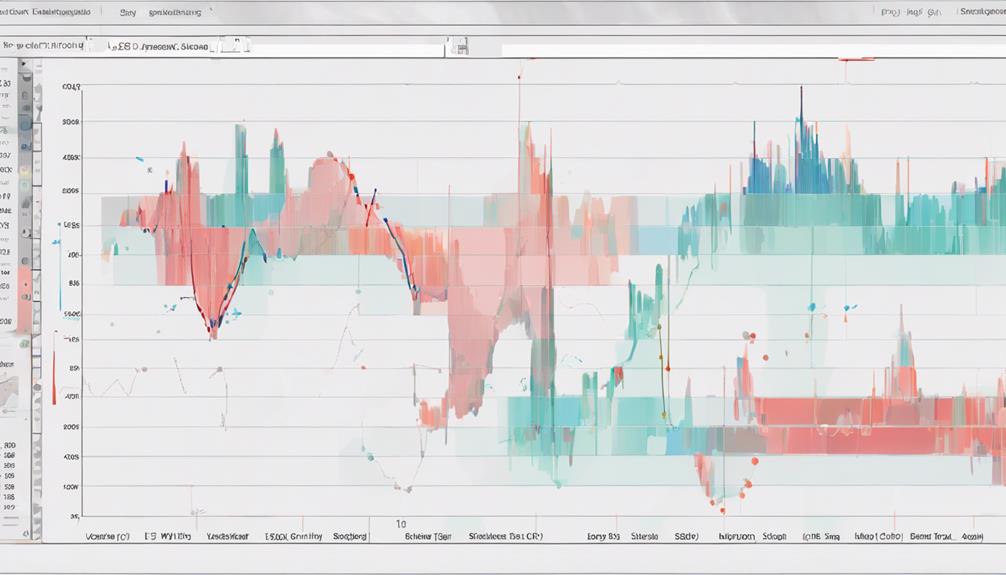You might think that mastering technical indicators is an insurmountable task, but by following these 10 best practices, you can navigate the complex world of trading with confidence.
From understanding different indicator types to optimizing their settings and integrating them effectively with price action, these practices are crucial for enhancing your trading skills.
But there's one key aspect that ties them all together, a fundamental principle that can make or break your success in utilizing technical indicators.
Understanding Technical Indicator Types
When analyzing market trends, it's essential to grasp the various types of technical indicators available for effectively interpreting price movements. Moving Averages, Bollinger Bands, and RSI are key upper technical indicators used for trend analysis.
Moving Averages smooth out price data to identify trends over specific periods, providing insights into the direction of the market. Bollinger Bands, on the other hand, consist of a simple moving average with upper and lower bands that expand and contract based on volatility, helping traders spot potential reversal points. RSI, a popular oscillator, measures the speed and change of price movements to determine overbought or oversold conditions, indicating potential trend reversals.
Understanding these technical indicator types is fundamental for making informed trading decisions based on market signals.
Choosing the Right Indicator Combination

To optimize your technical analysis strategy, the selection of indicator combinations should be tailored to specific market conditions and aligned with your trading objectives.
Consider using a mix of trend-following, momentum, and volatility indicators to gain comprehensive insights. Avoid redundancy by choosing indicators that offer unique signals. Testing different combinations is essential to identify the most effective setup for your trading style.
Combining leading and lagging indicators can enhance the accuracy of trade signals and decisions. By carefully selecting indicator combinations based on market conditions and your objectives, you can create a robust analysis framework that supports your trading strategy effectively.
Setting Clear Objectives for Indicator Use

Develop specific objectives for each technical indicator incorporated into your trading strategies to enhance decision-making and performance analysis.
Clearly outline how each indicator will contribute to identifying entry and exit points.
Establish measurable goals for the indicators to ensure signal accuracy and effectiveness in risk management.
By setting clear objectives, you can align the technical indicators with your overall trading goals, allowing for a more structured and informed approach to decision-making.
Define criteria for adjusting indicator settings based on evolving market conditions to optimize performance.
This proactive approach will enable you to adapt your strategies in real-time and maximize the utility of technical indicators in achieving your trading objectives.
Monitoring Indicator Performance Regularly
Regularly monitoring the performance of technical indicators is crucial to ensure the accuracy and reliability of the signals they provide in guiding your trading decisions. By evaluating the effectiveness of indicators in different market conditions, you can adapt your trading strategies accordingly.
It's essential to compare indicator signals with actual price movements to gauge their predictive power accurately. This practice allows you to identify discrepancies and make informed decisions based on real market dynamics.
Additionally, tracking the consistency and success rate of indicator signals over time enables you to optimize your trading performance effectively. Consider adjusting indicator settings or replacing ineffective ones to enhance the quality of your trading analysis and decision-making process.
Avoiding Indicator Overload in Analysis

When analyzing the market, it's crucial to select relevant indicators that complement each other rather than overwhelm you with information.
Setting clear parameters for each indicator can help you avoid conflicting signals and focus on essential data points.
Selecting Relevant Indicators
To effectively avoid indicator overload in your analysis, focus on selecting a concise set of indicators that align with your trading strategy and provide relevant insights for the current market conditions. When choosing indicators, remember to consider the uniqueness of the information they offer to prevent redundancy in your analysis.
Here are three key points to keep in mind:
- Select indicators that directly correlate with your trading strategy to enhance decision-making.
- Consider the current market conditions and choose indicators that provide valuable insights specific to the present environment.
- Prioritize indicators that complement each other to gain a well-rounded perspective on the market trends.
Setting Clear Parameters
Setting clear parameters in your analysis is crucial for avoiding indicator overload and focusing on essential data points that enhance the accuracy of your decision-making process.
When utilizing technical indicators such as the Moving Average or Momentum Indicator, it's vital to establish specific values for indicator inputs. This practice not only prevents redundancy but also ensures a streamlined and effective analysis process.
Minimizing Redundancy Risks
Minimizing redundancy risks in technical analysis requires a strategic selection of indicators that offer unique insights and avoiding overlap between them. When it comes to trading, overloading on indicators can lead to confusion and conflicting signals, hindering effective decision-making.
To prevent this, consider the following:
- Choose indicators that complement each other instead of providing duplicate information.
- Prioritize quality over quantity when selecting indicators for analysis.
- Regularly review and assess the usefulness of each indicator to ensure they add value to your trading strategy.
Considering the Market Environment

When analyzing technical indicators, it's essential to consider the market environment you're operating within. Assess market volatility levels to determine the most suitable indicators for high or low volatility conditions.
Additionally, stay informed about economic events that could impact the market and adjust your indicator settings accordingly.
Market Volatility Analysis
To effectively navigate market volatility, traders leverage technical indicators to analyze price fluctuations and adapt their trading strategies accordingly. Market volatility analysis involves assessing the degree of price fluctuations in a specific market or asset.
Traders use various technical indicators like Bollinger Bands or Average True Range (ATR) to gauge market volatility and identify periods of high and low volatility. Understanding market volatility is essential for setting appropriate stop-loss levels and determining position sizing. It assists traders in managing risk and capitalizing on price movements in different market environments.
Trend Identification Techniques
Navigating market volatility successfully requires not only leveraging technical indicators but also understanding the market environment to effectively identify trends. Trend identification involves analyzing price movements to determine the market trend's direction. Traders can utilize tools like moving averages, MACD, and trendlines to confirm trends.
Different time frames, such as short-term, medium-term, and long-term, play a crucial role in trend identification techniques. By combining indicators like MACD, RSI, and ADX, traders can gain a comprehensive view of the market trend, aiding in better decision-making.
It's essential to adapt these trend identification techniques to the specific market environment to enhance the accuracy of trend analysis and make informed trading decisions.
Event Impact Assessment
Assessing the impact of economic events and news on market sentiment requires a keen understanding of how traders react to these factors to gauge the overall market environment effectively.
When considering economic events:
- Observe how market sentiment shifts in response to major news updates.
- Stay informed about key economic indicators that influence market behavior.
- Analyze historical data to anticipate potential market reactions to upcoming events.
Using Indicators in Confluence With Price Action

When combining technical indicators with price action analysis, traders can gain valuable insights into trade confirmation and decision-making processes. Price action, reflecting all influencing factors on a chart, can enhance the accuracy of trade signals generated by technical indicators.
By understanding how price action interacts with indicators, traders can validate or invalidate signals, providing a holistic view of market dynamics. Many traders use price action to confirm entry and exit points identified by technical indicators, leading to more reliable trading strategies.
This confluence allows for a deeper understanding of market movements and can significantly improve the effectiveness of trading decisions. By incorporating both price action and technical indicators, traders can create a more robust trading approach.
Testing and Adjusting Indicator Parameters

When adjusting indicator parameters, consider factors like:
- Periods
- Smoothing
- Thresholds
to optimize performance for your trading style.
Testing various parameter values through backtesting can help identify the most effective settings for accurate signals.
Understanding how these adjustments impact signal timeliness is essential for refining indicators and improving signal reliability.
Optimal Parameter Settings
Discovering the ideal parameter settings for technical indicators involves meticulous experimentation and analysis to enhance trading accuracy and reliability. Traders can optimize indicator parameters through testing and adjusting to improve signal generation for better decision-making.
To achieve this, consider the following:
- Experiment with different periods, smoothing factors, and threshold levels to find the most suitable configuration.
- Utilize backtesting, demo accounts, and paper trading to assess the impact of parameter adjustments on signal timeliness and effectiveness.
- Understand how changes in indicator parameters influence signal generation to fine-tune your strategies for optimal performance.
Fine-Tuning for Accuracy
To optimize the performance of technical indicators, meticulous testing and adjustment of indicator parameters are essential for fine-tuning accuracy and reducing false signals in trading strategies.
Adjusting parameters such as periods, smoothing, and thresholds allows for optimization.
Backtesting with various parameter settings is crucial to evaluate indicator accuracy across different market conditions.
Understanding how parameter changes affect signal timeliness is key to refining indicator effectiveness.
Experimenting with settings on demo accounts or through paper trading offers valuable insights into choosing the best parameters for specific trading styles.
Fine-tuning indicator parameters is a fundamental step in maximizing accuracy and minimizing false signals, ultimately enhancing the overall performance of trading strategies.
Practicing Patience and Discipline in Indicator Use

Practicing patience and maintaining discipline in utilizing technical indicators are essential components for achieving success in trading strategies. When engaging with indicators, remember:
- Patience is a virtue; signals may not always be immediate.
- Discipline is crucial; follow your predefined strategy to avoid impulsive decisions.
- Understand the limitations of indicators; they may lag during market fluctuations.
Seeking Continuous Education on Indicators

Continuous learning about technical indicators is paramount for traders seeking to enhance their market understanding and trading performance. Staying informed about market trends and opportunities through ongoing education on technical indicators is crucial. Understanding the intricacies and nuances of various indicators can significantly improve trading strategies and decision-making processes. By regularly updating knowledge on indicator usage and interpretation, traders can experience enhanced trading performance.
Engaging in online resources, courses, and communities is essential for gaining valuable insights and practical applications of technical indicators. Continuous education allows traders to adapt to changing market conditions effectively and refine their trading approaches to achieve better results in their trading strategies.
How Can I Implement Basic Technical Indicators in my Trading Strategy?
Understanding the basic technical indicators importance is key in implementing them into your trading strategy. Start by learning about simple moving averages, relative strength index, and MACD. These indicators can help you make informed decisions and improve your overall trading performance.
Frequently Asked Questions
What Is the Best Way to Practice Technical Analysis?
To practice technical analysis effectively, start by studying historical data and experimenting with various indicators. Use demo accounts for risk-free testing. Engage with trading communities, attend workshops, and regularly evaluate trades for continuous improvement in your skills.
What Are the Top 5 Technical Analysis Indicators?
Identify trends and reversals with Moving Averages, spot overbought or oversold conditions using RSI, watch for potential trend changes with MACD, pinpoint price extremes with Bollinger Bands, and gauge momentum/reversals with Stochastic Oscillator.
What Is the Best Combination of Technical Indicators?
Begin by identifying your trading goals and preferred analysis approach. Combine indicators like Moving Averages and RSI for a comprehensive view. Avoid redundancy and contradiction. Choose complementary pairs like MACD and Stochastic for confirmation. Tailor your choices to suit your style and risk tolerance.
How Many Technical Indicators Should You Use?
When deciding on the number of technical indicators to use, remember quality over quantity. Focus on a few reliable indicators to avoid confusion. Strike the right balance for clear insights without overwhelming yourself with redundant data.
Conclusion
As you navigate the world of technical indicators, remember to treat them like tools in your trading toolbox. Just as a skilled craftsman carefully selects and uses the right tool for the job, you must choose your indicators wisely and apply them with precision.
Like a painter carefully selecting and blending colors on their palette, combining indicators thoughtfully can create a masterpiece of analysis and insight in the ever-changing canvas of the market.
Stay focused, stay disciplined, and continue to refine your skills to become a master of your craft.


